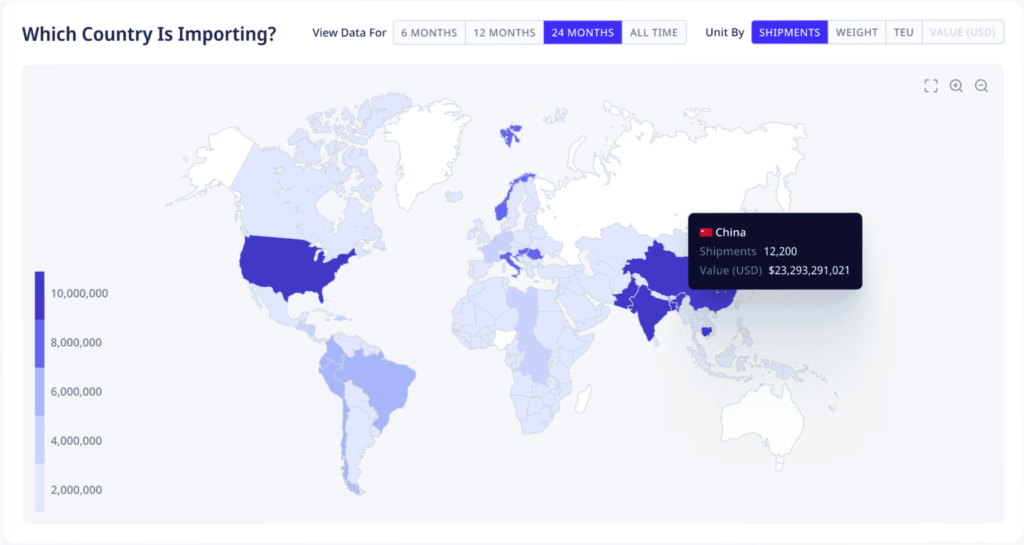Market Analytics Data
ADAMftd provides comprehensive market analytics data for global trade, allowing users to analyze shipments, weight, TEU (Twenty-foot Equivalent Unit), as well as buyer and supplier lists for any product worldwide. The Market Analytics Data table shows monthly data, enabling importers, exporters, and manufacturers to track trade volumes, understand market dynamics, and identify potential business partners. This table includes columns for the month and year of the data, number of shipments recorded, total weight of shipments in kilograms, number of containers measured in TEUs, monetary value of shipments, and the number of buyers and suppliers involved. This data benefits stakeholders by providing detailed insights into trade activities, helping them plan and optimize their operations accordingly.

Global Import Analysis
The “Which Country Is Importing?” map visualization allows users to see the distribution of imports across different countries over various timeframes. This map can be filtered by shipments, weight, TEU, or value, providing a clear understanding of international demand. Users can view data for different periods, such as 6 months, 12 months, 24 months, or all time, and filter the data by shipments, weight, TEU, or value. This feature is unique to ADAMftd as it visually represents trade flow, making it easier for businesses to identify key markets and emerging trends, thereby aiding in strategic decision-making.

Buyer Country Data
The Buyer Country Data table breaks down the number of shipments, weight, TEU, value, and the number of buyers from various countries. This detailed breakdown helps users understand where demand is coming from and the scale of import activities. The table lists countries involved in the trade, number of shipments per country, total weight of shipments per country, container count per country, financial value of shipments, and the number of buyers in each country. For importers and manufacturers, this data helps identify key markets and potential buyers, facilitating targeted marketing and sales efforts.

Supply Country Data
Similar to Buyer Country Data, the Supply Country Data table provides insights into the number of shipments, weight, TEU, value, and the number of suppliers from different countries. This data is crucial for exporters and manufacturers looking to understand their supply chain and identify reliable suppliers. The table includes columns for the countries involved in the trade of items specified, number of shipments per country, total weight of shipments per country, container count per country, financial value of shipments, and the number of suppliers in each country. This feature allows users to analyze their supply sources and optimize their procurement strategies.

Unique Features of ADAMftd
ADAMftd stands out by offering a comprehensive suite of tools for global trade analysis. The detailed market analytics, combined with visual data representation and breakdowns of buyer and supplier data, provide users with actionable insights. These features support strategic planning, market entry decisions, and operational optimization, making ADAMftd an invaluable tool for anyone involved in international trade.
Trade Area Analysis Use Cases

Analyzing Top Trading Regions
By examining the top trading areas, businesses can identify key regions that account for the majority of their trade activities. This helps in focusing marketing and operational efforts on the most significant markets, optimizing resource allocation, and maximizing trade opportunities.

Understanding Trade Proportions by Region
Trade area analysis provides insights into the geographical distribution of trade activities, such as the proportion of shipments by continent and country. This information helps businesses understand market penetration and regional demand, aiding in strategic planning and regional expansion.

Tracking Shipments by Quantity and Value
Monitoring the volume and value of shipments in different regions helps businesses assess the economic impact of their trade activities. Understanding shipment metrics enables better financial planning, pricing strategies, and supply chain management, ensuring profitability and efficiency.

Viewing Trade Data Over Different Time Periods
Analyzing trade data over various time frames, such as the last 6, 12, or 24 months, allows businesses to identify trends and seasonal patterns. This helps in forecasting demand, planning inventory, and making informed decisions about market entry and exit strategies.

Differentiating Between Buying and Selling Regions
Trade area analysis helps businesses differentiate between regions where they are primarily importing or exporting. Understanding the balance between buying and selling markets aids in optimizing trade strategies, managing supply chain logistics, and identifying opportunities for market diversification.

